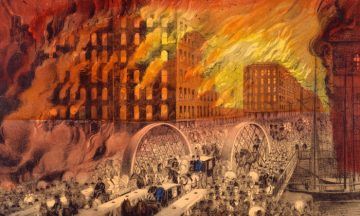Hannah B. Higgins in The MIT Press Reader:
 Called shikaakwa by the Miami-Illinois tribe for the skunky smell of the wild-onion that grew on the banks of Lake Michigan, “Chicago” is a French transcription of the earlier name for the area. Founded in 1833, with an initial population of 350, before the fire, it is said, Chicago’s streets curved around the Lake Michigan waterfront and followed the course of the Chicago River and a network of cattle paths lain over Native American migration routes. In contrast to the organic form of the city associated with the early settlers, modern Chicago would be organized as a grid, with address numbers (beginning in 1909) that could tell any pedestrian where they were in relationship to the central point (0,0) of State and Madison streets. According to plan, the modules of this new grid, great skyscrapers, grew up from the rubble like gigantic, up-stretched skeletons of cast iron and, later, steel. The grid, “a framework of spaced parallel bars” according to the Oxford American Dictionary, appears here as the image of an emerging modernity.
Called shikaakwa by the Miami-Illinois tribe for the skunky smell of the wild-onion that grew on the banks of Lake Michigan, “Chicago” is a French transcription of the earlier name for the area. Founded in 1833, with an initial population of 350, before the fire, it is said, Chicago’s streets curved around the Lake Michigan waterfront and followed the course of the Chicago River and a network of cattle paths lain over Native American migration routes. In contrast to the organic form of the city associated with the early settlers, modern Chicago would be organized as a grid, with address numbers (beginning in 1909) that could tell any pedestrian where they were in relationship to the central point (0,0) of State and Madison streets. According to plan, the modules of this new grid, great skyscrapers, grew up from the rubble like gigantic, up-stretched skeletons of cast iron and, later, steel. The grid, “a framework of spaced parallel bars” according to the Oxford American Dictionary, appears here as the image of an emerging modernity.
More here.
